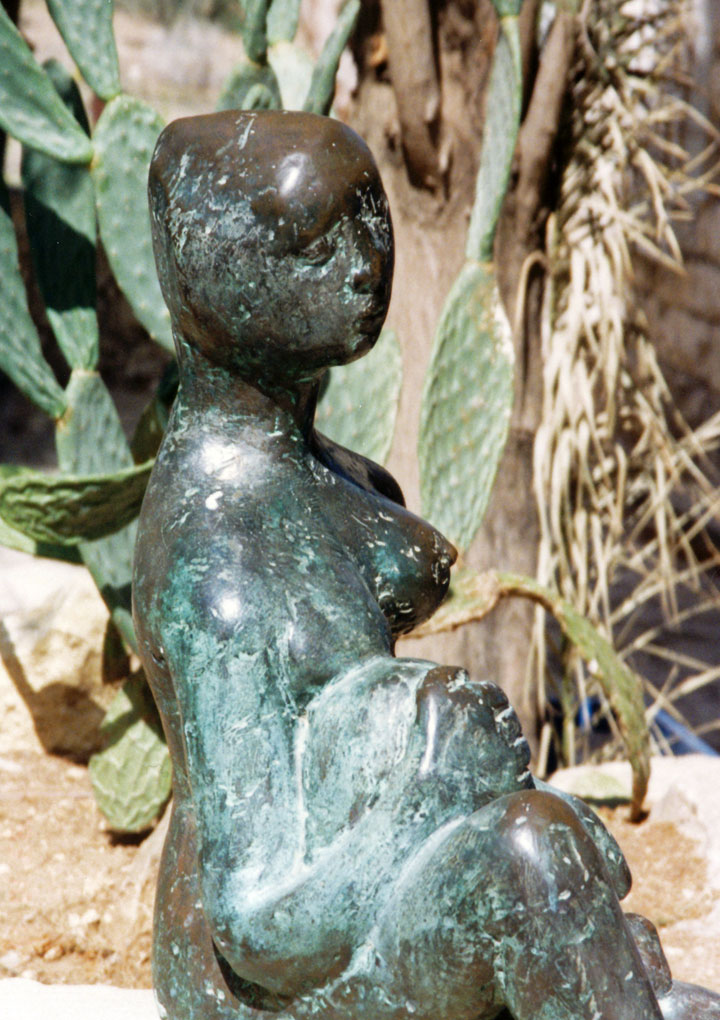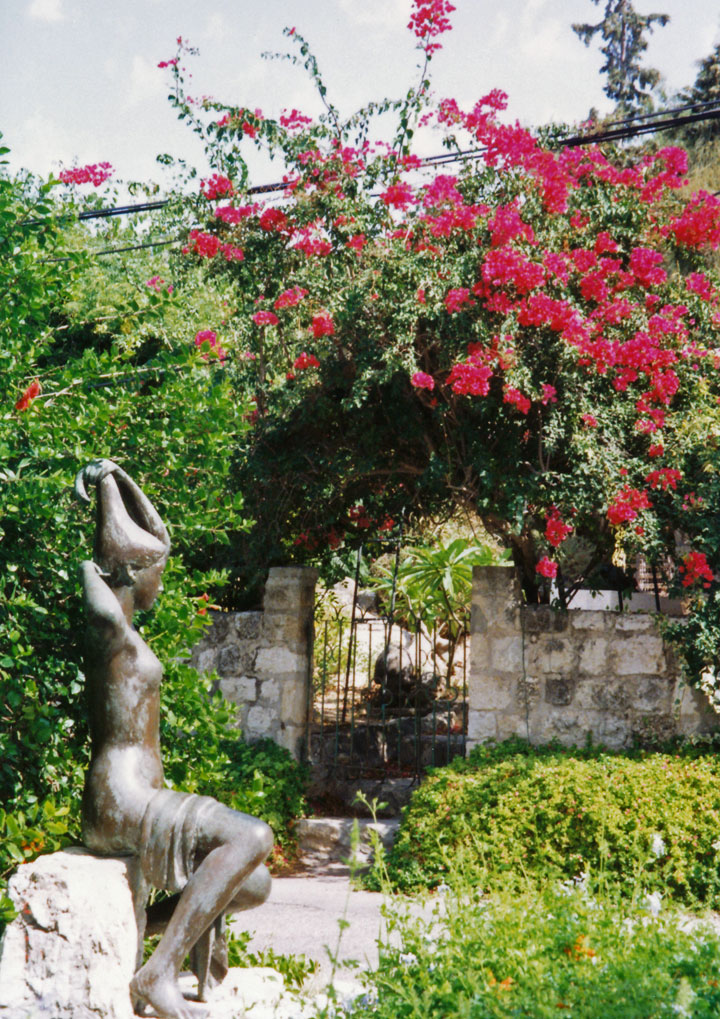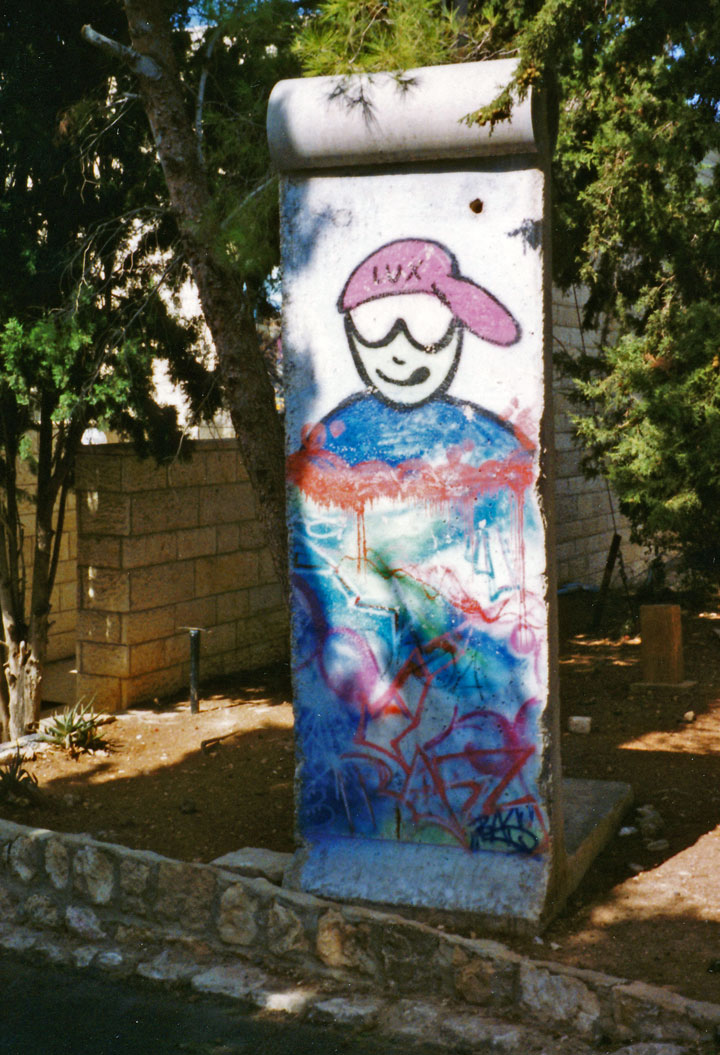

Ein Hod
Ein Hod (Hebrew: עֵין הוֹד) is a communal settlement in northern Israel. Located south of Mount Carmel and southeast of Haifa in northern Israel, it falls under the jurisdiction of Hof HaCarmel Regional Council. In 2006 it had a population of 519.

Art of Ein Hod
The village is situated on a hillside
amidst olive groves, with a view of the Mediterranean Sea and a twelfth-century
Crusader fortress. Prior to the 1948 Arab-Israeli War Ein Hod was the site of
the Palestinian village of Ein Hawd. Most of the Arab inhabitants were displaced
as a result of the war but some remained in the area and settled nearby, forming
a new village, also by the name of Ein Hawd. After a failed attempt to create a
moshav on the site, Ein Hod became an artists' colony in 1953.
Excavations in the Carmel region indicate that human settlement in the area
dates back over 150,000 years.
The village was one of the "Al-Hija" villages named after Emir Hussam al-Din Abu
al-Hija. Abu al-Hija ("the Daring") was an Iraqi-born commander of the Kurdish
forces that took part in Sultan Saladin´s conquest (1187-93) of the Crusader
Kingdom. He was renowned for his bravery, and commanded the garrison of Acre at
the time of the Siege of Acre (1189-1192).
Abu al-Hija apparently returned to Iraq, but several members of his family
remained in the country under orders from Saladin, and these family members
settled on spacious tracts of land that they were granted in the Carmel region,
in the Lower, Eastern and Western Galilee, and in the Hebron Highlands.[5] One
of these land grants became the village of Ein Hawd. Other al-Hija villages were
Hadatha and Sirin in the Lower Galilee, Ruweis and Kawkab in the Western
Galilee. By tradition the remaining residents today still claim to be blood
relations of al-Hija.
In 1596, the village of Ayn Hawd was part of the Ottoman Empire, nahiya (subdistrict)
of Shafa under the liwa' (district) of Lajjun with a population of 44. The
villagers paid taxes on crops such as wheat and barley, as well as on goats and
beehives.
In 1852 the Dutch traveler van der Velde visited "Ain Haud" and "spent a
pleasant evening in Shech Soleiman's house". Van der Velde describes how the
villagers, all Muslim, were in great alarm over conscription to the Ottoman
army. According to Shech Soleiman a former Sultan had given them a firman,
exempting the villagers from conscription.

In the late nineteenth century, "Ain Haud" was described as a small village
situated on the end of a spur, inhabited by fifty people who cultivated 3
faddans of land. The village elementary school for boys was founded in 1888.
Most of the 700-900 Arab villagers of Ein Hod from before the 1948 Arab-Israeli
War resettled in the West Bank, many in Jenin refugee camp. A group of 35
original inhabitants, many of them members of the Abu al-Hija family, took
shelter in a nearby wadi. Attempts to dispossess them by legal means did not
succeed. This new village was named Ein Houd. Initially, the Israeli authorities
did not recognize the village. In 1988, residents of Ein Houd helped to form the
association of the Arab Unrecognized Villages in Israel. In 1992, the state
officially recognized the village, but it was only granted full recognition in
2005, when it was connected to Israel's electric grid.
In July 1949 the Moshavim Movement settled immigrants from Tunisia and Algeria
in the depopulated village, renaming the village Ein Hod. The movement allocated
instructors to the new settlers as the agricultural endeavor. The short lived
re-use of the village as an agricultural concern was abandoned and the village
remained deserted for a further year and a half.
Ein Hod became an artists' colony in 1953. The driving spirit behind the project
was Marcel Janco, an acclaimed Dada artist, who kept the village from being
demolished by the security forces and convinced the government to let him build
an artists' colony there.
Ein Hod is now a communal settlement run by an elected administrative committee.
Many Israeli painters, sculptors and musicians live there, and maintain studios
and galleries that are open to the public. Efforts have been made to preserve
some of the old houses. The village mosque was converted into a restaurant-bar
modeled after Cafe Voltaire in Zurich.

Ein Hod has 22 galleries, 14 art workshops, 2 museums and 14 rooms for rent to
tourists. Workshops include printing, sculpture, photography, silk screening,
music (vocal), ceramics, mosaics, design, stained glass, lithography and
blacksmithing. The Gertrud Kraus House sponsors biweekly chamber music
concerts and guest lectures. During the summer months, performances of popular
music and light entertainment take place in an outdoor amphitheatre. Throughout
the year, free outdoor jazz concerts are held on Saturdays near the village's
central square.
Ein Hod's main gallery has five exhibition halls, each devoted to a different
artistic sector. Hall 1 exhibits art by immigrants from the former Soviet Union
and Ethiopia; Hall 2 is exclusively for Ein Hod artists, past and present; Halls
3 and 4 are for changing exhibitions, solo and group shows of residents and
outsiders; and Hall 5 is for theme shows.
The Nisco Museum of Mechanical Music in Ein Hod is the first museum in Israel
dedicated to antique musical instruments.The collection, accumulated over 40
years by Nisan Cohen, contains music boxes, hurdy gurdies, an automatic organ, a
reproducing player piano, a collection of 100 year-old manivelles, gramophones,
hand-operated automatic pianos and other instruments.
The Düsseldorf-Ein Hod exchange program has brought Düsseldorf artists to Ein
Hod and vice versa over the past two decades. A similar program has been
inaugurated for artists from New Hampshire.
An early resident was the American children's writer and amateur archaeologist
Nora Benjamin Kubie. One of Ein Hod's veteran artists is Ursula Malbin, whose
bronze sculptures have been on display since 1978 in Haifa's Vista of Peace
Garden, the first public sculpture garden in Israel dedicated solely to the
works of a woman sculptor. Avraham eilat a multimedia artist whose latest video
art installtaion "Psychophysical Time" is shown in several leading art events in
Europe.Dina Merhav creates sculptures from old metal utensils and industrial
machine parts. One of her works, Totem, was exhibited at the Olympic Sculpture
Garden in Beijing, China, when the Olympic Games were held there.

view from the hill toward the agricultural land and the sea
Dan Chamizer, creator of the "Chamizer
riddle," is a resident of Ein Hod. Based on an original coding system, the
Chamizer riddle is widely used to teach problem-solving in schools, government
agencies and high-tech companies.
Ten Ein Hod residents have won the Israel Prize, awarded annually on Israel
Independence Day. According to Robert Nechin, who lives in the village, the
artists working there today "are fully aware of the illustrious example of these
great artists and scholars, who lived and are still living among them. Ein Hod
residents who have won the prize are:
* Zahara Schatz, painting and sculpture (1955)
* Marcel Janco, for painting (1967)
* Gertrud Kraus for dance (1968)
* Simon Halkin, for literature (1975)
* Haim Hefer, for Hebrew songwriting (1983)
* Natan Zach, for poetry (1995)
* Aryeh Navon, for theater scenery and art (1996)
* Michael Gross, for painting and sculpture (2000)
* Gavri Banai, for his special contribution to Israeli culture as a member of
the HaGashash HaHiver comedy trio (2000)
* Gila Almagor, for acting (2004)
Text from Wikipedia